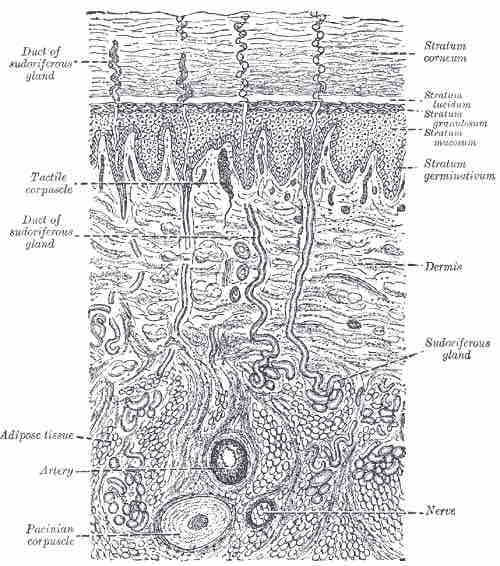The skin is one of the most important body parts because it interfaces with the environment and is the first line of defense from external factors. While it performs a wide range of functions, including sensation, heat regulation, control of evaporation, storage, synthesis, absorption, and water resistance, but its innate immune system functions as the barrier immune system are the most critical.
In humans, the outer covering of the body consists of the skin and mucosae, which together make up the barrier immune system.
Components of the Skin
The skin is made up of several layers that together protect the body, regulate temperature, keep water inside the body, and have sensory function. The skin is the largest organ in the body, and consists of three components that differ greatly in structure and function:
- The epidermis comprises the outermost layers of the skin. It forms a protective barrier over the body's surface, responsible for keeping water in the body and preventing pathogens from entering. It is made of stratified squamous epithelium tissues, composed of proliferating basal and differentiated suprabasal keratinocytes that form an extracellular matrix that continually divides as the older outer layers of the epidermis shed. The epidermis also helps the skin regulate body temperature through sweat pores that connect to underlying sweat glands in the dermis.
- The basement membrane is a thin sheet of fibers called the basement membrane that separates the dermis and epidermis. It controls the traffic of cells and molecules between the dermis and epidermis and the release of cytokines and growth factors during wound healing.
- The dermis is the layer of skin beneath the epidermis that consists of connective tissue and cushions the body from stress and strain. The dermis provides strength and elasticity to the skin through an extracellular matrix composed of collagen fibrils, microfibrils, and elastic fibers, embedded in proteoglycans. It harbors many mechanoreceptors (sensory nerve endings) that provide the sensations of touch and heat. It also contains the hair follicles, sweat glands, sebaceous glands, apocrine glands, lymphatic vessels, and blood vessels. The blood vessels in the dermis provide nourishment and waste removal for their own cells and for the epidermis.
Mucous Membranes
The mucous membranes (or mucosae; singular mucosa) are linings of mostly endodermal origin, covered in various types of epithelium, that are involved in absorption and secretion. They line cavities that are exposed to the external environment and internal organs. They attached to skin at the nostrils, mouth, lips, eyelids, and genital area, but are also located within the body cavities, such as in the stomach, anus, trachea, and ears.
Most mucous membranes secrete a sticky, thick fluid called mucus, which facilitates several barrier immune system functions and provides a moist environment for internal and semi-internal structures. The mucosae are highly specialized in each organ to deal with different conditions. The most variation is seen in the epithelium. In the esophagus and oropharynx, the epithelium is stratified, squamous and non-keratinising, to protect these areas from harsh or acidic foods. In the stomach it is columnar and organized into gastric pits and glands to secrete acids and pepsin. The small intestine epithelium is specialized for absorption, organized into simple columnar epithelium on protruding villi with narrow crypts that have a high surface area. The mucosal epithelium in the nasopharynx is psuedostratified and ciliated, which helps accumulate and remove mucus.
The Barrier Immune System
Together, the skin and mucosae form the the barrier immune system, technically considered a component of the innate immune system. These structures form physical barriers to infection that prevent pathogens from entering the body through a variety of methods. While the skin simply prevents pathogen entry, more specialized structures like the mucociliary escalator in the trachea trap pathogens in mucus secretions and use cilia to push them out of the trachea to prevent entry into the lungs.
The barrier system also includes chemical barriers that prevent pathogen entry. Notable examples include stomach acidity which kills most microbes, antimicrobial peptides on mucosal epithelial tissue, and even the flow of urine that flushes pathogens out of the urethra.
The barrier system is the first line of defense against pathogen invasion, though it is not perfect. The skin can be broken through cuts or abrasions that expose the bloodstream to the environment. Not every pathogen is caught nor inhibited in mucus, and some may infect the mucosal epithelium directly. Smoking and alcohol abuse damage the muciliary escalator and make it easier for pathogens to invade the lungs. Fortunately, other mechanisms of the innate and adaptive immune systems defend the body when the barrier system fails.

Dermis
A diagrammatic view of a skin section.